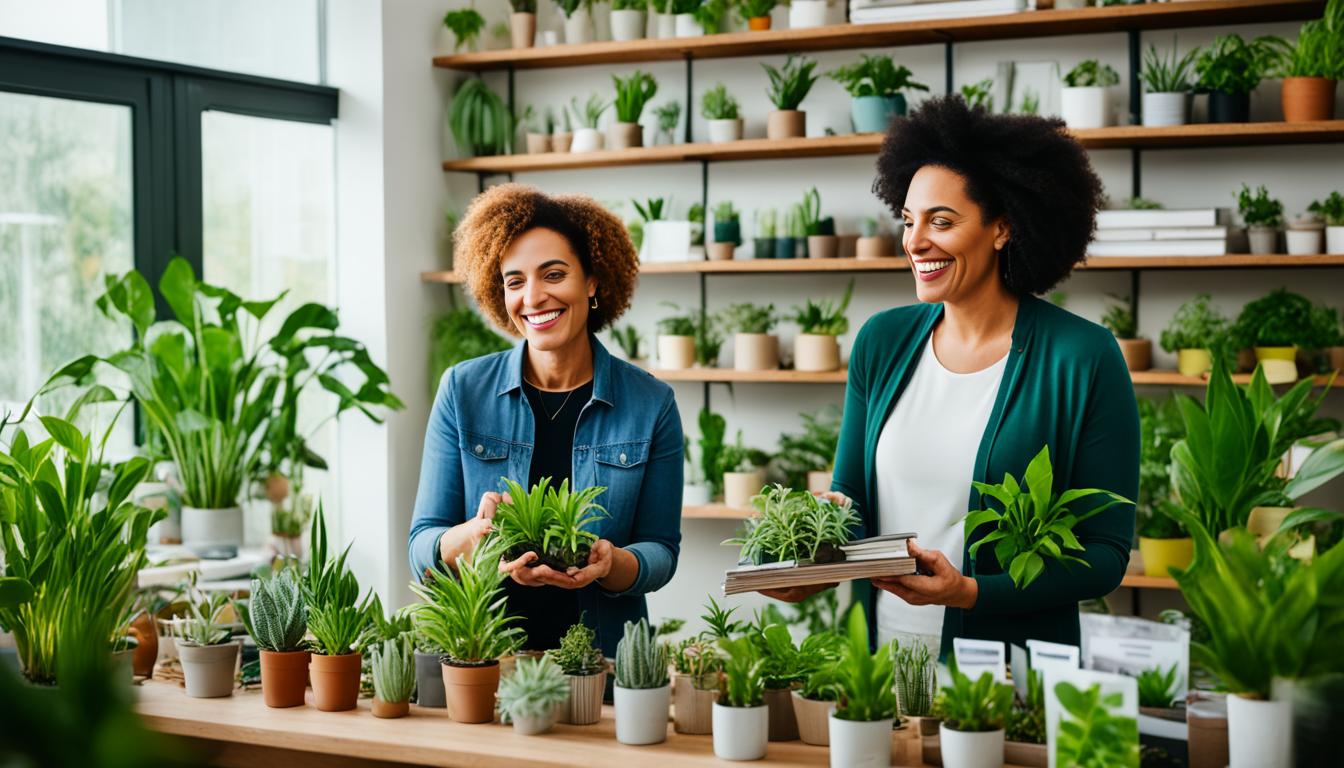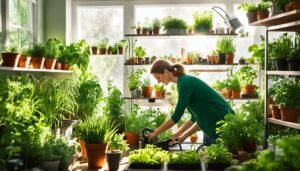Do you want to take your indoor plant care game to the next level? Are you looking for expert tips and tricks to keep your plants thriving? What if we told you that there is a whole community waiting to offer support, share experiences, and help you unlock the secrets of successful indoor gardening? Welcome to the thriving indoor plant care community, where enthusiasts come together to nurture their green companions and create an oasis of nature within their homes.
- Joining an indoor plant care community can provide valuable tips and tricks for successful plant care.
- Connecting with fellow enthusiasts allows you to share experiences and learn from each other.
- The indoor plant care community offers a supportive space where you can ask questions and seek advice.
- Accessing available resources within the community can help you troubleshoot common plant care issues.
- By leveraging the knowledge of the community, you can enhance your indoor plant care skills and create a thriving green oasis in your home.
The Value of the Multicultural Classroom
Projective integration is a pedagogical approach that recognizes the growing significance of multilingualism, global awareness, and cross-cultural communication skills in shaping future societies. It calls on educators to create a multicultural classroom that embraces the diversity of students’ backgrounds and experiences. By fostering an environment that values inclusivity and cultural sustenance, projective integration promotes social responsiveness, care, and understanding among students.
The metaphor of a garden beautifully exemplifies the projective integration approach. Just as a garden thrives with a variety of plants, a multicultural classroom flourishes when students from different cultural backgrounds come together, enriching the learning environment with their unique perspectives and lived experiences. In a garden, plants coexist, nourished by the same soil and sunlight. Similarly, in a multicultural classroom, students, regardless of their cultural heritage, can learn and grow together, benefiting from shared knowledge and diverse perspectives.
Embracing Differences
Creating a multicultural classroom begins with embracing and celebrating the differences among students. Rather than viewing diversity as a challenge, educators approach it as an opportunity for growth and learning. Recognizing and valuing students’ cultures, languages, and identities fosters a sense of belonging and pride, empowering students to bring their authentic selves into the learning environment.
Culturally Sustaining Pedagogy
Culturally sustaining pedagogy is a key component of projective integration. It involves incorporating students’ cultural backgrounds and experiences into the curriculum, instructional methods, and classroom activities. By integrating cultural resources into the learning process, educators can create meaningful connections between students’ lived realities and the subject matter, making the content more accessible and engaging.
Promoting Cross-Cultural Communication
A multicultural classroom serves as a platform for promoting cross-cultural communication skills. Students have the opportunity to interact with peers from diverse backgrounds, learn about different customs and traditions, and develop a global perspective. These interactions foster empathy, tolerance, and collaboration among students, preparing them for a future where intercultural communication is integral to personal and professional success.
A culturally and linguistically diverse classroom mirrors the richness and complexity of the world we live in. By nurturing a multicultural environment, educators lay the foundation for a more inclusive and equitable society.
An example of projective integration in action is the use of culturally relevant literature in the classroom. By incorporating books and stories that reflect the experiences of students from various cultural backgrounds, educators validate, honor, and amplify the voices and narratives of underrepresented communities.
Benefits of the Multicultural Classroom
The multicultural classroom offers numerous benefits for students, including:
- Enhanced cultural competence
- Increased empathy and understanding
- Improved communication and collaboration skills
- Expanded worldviews and global awareness
- Empowerment of marginalized voices
These benefits extend beyond the classroom, equipping students with the tools and perspectives necessary to navigate an interconnected and diverse society.
Culturally Sustaining Pedagogy Strategies
| Strategies | Description |
|---|---|
| Curriculum Integration | Integrate students’ cultural backgrounds and experiences into the curriculum to make it more relevant and inclusive. |
| Language Support | Provide language support for English language learners and value the linguistic diversity present in the classroom. |
| Community Engagement | Collaborate with local communities and invite guest speakers to share their cultural experiences and knowledge with students. |
| Critical Reflection | Encourage students to critically reflect on their own cultural identities and biases to foster self-awareness and empathy. |
| Interdisciplinary Approaches | Integrate various subjects and disciplines to provide a holistic understanding of diverse cultures and perspectives. |
All Plants in the Garden Look Different
Traditional education systems often prioritize standardized outcomes and uniform teaching methods, overlooking the diversity of thinking and learning styles in a diverse society. The garden metaphor challenges this approach and invites you to become a horticulturalist, nurturing the unique growth and learning potential of each student. By embracing differentiated instruction and employing a horticulturalist approach, you can cater to the diverse experiences and interdependence among students, thereby promoting a culture that appreciates and celebrates differences.
Just as plants in a garden come in different shapes, sizes, and colors, students also have unique strengths, interests, and ways of learning. Adopting differentiated instruction allows you to tailor your teaching methods to meet the individual needs of each student. This approach recognizes that diversity in thinking and learning is not a hindrance but a valuable asset, contributing to the overall richness of the learning environment.
Understanding Diversity in Thinking and Learning
Students have different ways of processing information, comprehending concepts, and expressing their understanding. Some may be visual learners who benefit from visual aids and diagrams, while others may be auditory learners who prefer listening to explanations. There are also kinesthetic learners who thrive through hands-on activities and movement. By recognizing and accommodating these diverse learning styles, you can create an inclusive classroom where every student has the opportunity to thrive.
Moreover, diversity in thinking extends beyond learning styles. Students bring with them unique cultural backgrounds, varied life experiences, and individual perspectives. Embracing this diversity fosters an environment where students can learn from one another, build empathy, and develop a broader worldview.
Just as a garden with a variety of plants is visually captivating, a classroom with diverse students is intellectually stimulating.
Cultivating the Growth of Every Student
As a horticulturalist tends to each plant’s specific needs, you can nurture the growth of each student by providing differentiated instruction. This involves tailoring your teaching methods, assignments, and assessments to accommodate individual learning styles and preferences. By identifying the strengths and interests of your students, you can create a learning environment that motivates and engages them, catered specifically to their needs.
Creating opportunities for students to collaborate, work in groups, and share their diverse perspectives also promotes interdependence and cultural understanding. Encourage discussions, debates, and projects that allow students to learn from one another, challenge their assumptions, and appreciate different ways of thinking. Just as plants thrive when they receive the right amount of sunlight, water, and nutrients, students flourish when they are provided with the support and resources that cater to their unique learning needs.
Embracing the Diversity in Your Classroom
Embracing diversity goes beyond acknowledging differences; it requires fostering a classroom culture that celebrates and values each student’s uniqueness. Encourage mutual respect, empathy, and open-mindedness among your students. By creating an inclusive environment where students feel safe to express their thoughts and opinions, you can cultivate an atmosphere of trust and collaboration.
Take the time to learn about your students’ cultural backgrounds, traditions, and experiences. Incorporate diverse perspectives into your curriculum by including literature, art, and history from different cultures. By incorporating various perspectives and experiences, you not only validate the identities of your students but also provide them with a well-rounded education that prepares them for the diverse world outside the classroom.
| Differentiated Instruction | Diversity in Thinking and Learning | Horticulturalist Approach |
|---|---|---|
| Customizing teaching methods to meet individual needs | Recognizing and celebrating diverse ways of thinking and learning | Nurturing the growth and learning potential of each student |
| Accommodating various learning styles and preferences | Fostering an environment of cultural understanding | Tailoring teaching methods to cater to individual strengths and interests |
| Promoting collaboration and interdependence among students | Cultivating empathy and diverse perspectives | Creating an inclusive classroom culture that values uniqueness |

The horticulturalist approach to education encourages you to embrace differentiated instruction, appreciate the diversity in thinking and learning, and create an inclusive and supportive classroom. By nurturing the growth of each student and celebrating their unique qualities, you can create a vibrant learning environment where every student can thrive.
All Plants in the Garden Share the Same Sun
Individualized learning is crucial for addressing the diverse needs of students. However, it is equally important to recognize that despite these individual needs, there are shared experiences and growth opportunities that can benefit all learners. Just like plants in a garden, students may have different perspectives and approaches, but they are united by their common ground and the desire for personal and academic growth.
Recognizing and navigating diverse perspectives is a fundamental aspect of education in a multicultural society. By embracing and celebrating the unique experiences and backgrounds of students, educators can create a rich learning environment that prepares them for the complexities of the real world.
Shared experiences play a vital role in fostering a sense of community and belonging among students. When students learn together, collaborate on projects, and engage in discussions, they not only develop essential skills but also gain a deeper understanding of diverse perspectives and cultures.
Growth is an inherent part of the learning process. Just as plants in a garden grow and thrive through shared resources and support, students flourish when they have access to a nurturing and inclusive educational environment. By emphasizing shared experiences and growth, educators can cultivate a culture of empathy, respect, and collaboration.
Nurturing a Garden of Learning
Just as a garden requires care and attention to flourish, fostering an environment that recognizes and leverages diverse perspectives and shared experiences requires intentional effort from educators. Here are some strategies for nurturing a garden of learning:
- Encourage collaborative projects and group discussions that promote the exchange of ideas and perspectives.
- Integrate diverse voices and perspectives into the curriculum to provide a holistic view of the subject matter.
- Facilitate open and respectful conversations that allow students to share their experiences and learn from one another.
- Offer opportunities for students to engage in hands-on activities that promote experiential learning and growth.
| Benefits of Recognizing Shared Experiences and Growth in Education | |
|---|---|
| Enhanced cultural understanding | |
| Increased empathy and respect | |
| Development of essential interpersonal skills | |
| Promotion of a sense of belonging |
“Education is not the filling of a pail, but the lighting of a fire.” – William Butler Yeats
Recognizing and embracing shared experiences and growth in education is a transformative process. It cultivates a sense of belonging, enhances cultural understanding, and equips students with the skills necessary to navigate a diverse and interconnected world. By nurturing a garden of learning, educators can empower students to thrive and make a positive impact in their communities.
All Roots Matter
Education reforms often prioritize standardized measures of progress, neglecting students’ socio-cultural understandings and backgrounds. It is crucial to recognize and appreciate the cultural roots of each student to create an inclusive and enriching educational environment. By fostering connections and promoting a multicultural atmosphere, educators can empower students to connect with their roots, explore diverse influences, and develop a strong sense of identity and belonging.
Appreciating cultural roots fosters a deeper understanding and appreciation of different traditions, histories, and perspectives. It allows students to draw strength from their heritage, while also developing empathy and respect for others. Socio-cultural understandings bring a unique richness to the educational experience, enhancing classroom discussions, collaborations, and learning outcomes.
Creating a Multicultural Environment
Creating a multicultural environment starts with acknowledging and valuing the diverse backgrounds of students. It involves incorporating culturally relevant materials, perspectives, and experiences into the curriculum. By doing so, educators provide opportunities for students to see themselves reflected in their learning and foster a sense of pride in their cultural heritage.
In a multicultural classroom, teachers can encourage students to share their own stories, traditions, and customs. This not only promotes cultural understanding but also cultivates a sense of belonging and acceptance among students. Through collaborative projects and activities, students can learn from one another’s backgrounds, developing a deeper appreciation for the diversity in their community.
Embracing cultural roots in education fosters a sense of belonging, empowers students to embrace diversity, and prepares them for an interconnected world.
Exploring Diverse Influences
Understanding cultural roots goes beyond recognizing one’s heritage. It also involves exploring diverse influences that have shaped individuals and communities. By studying different artistic movements, historical events, and societal changes, students gain insights into how diverse cultures have contributed to global progress.
Teachers can incorporate literature, music, art, and other forms of cultural expression from various backgrounds to create a rich tapestry of knowledge. This allows students to broaden their perspectives, challenge stereotypes, and develop a more comprehensive understanding of the world. Through these explorations, students become cultural ambassadors, fostering connections and building bridges between different communities.
Nurturing Connections through Appreciation
Appreciating cultural roots is an ongoing process that requires continuous learning, reflection, and open-mindedness. It involves creating a classroom culture that celebrates diversity and encourages dialogue about different cultural experiences. By fostering connections among students and their communities, educators help students understand the value of collaboration, empathy, and mutual respect.
Teachers can organize multicultural events, guest speaker sessions, or cultural exchange programs to provide opportunities for students to interact with individuals from diverse backgrounds effectively. These initiatives not only deepen socio-cultural understandings but also facilitate the formation of lasting connections that extend beyond the classroom.

By appreciating cultural roots, educators foster a sense of connection, encourage empathy, and equip students with the skills needed to navigate an increasingly diverse and interconnected world.
The Soil is Shared by All
Creating a supportive classroom environment is essential for teachers in nurturing mutual relationships and fostering a sense of belonging among students. The metaphor of a garden reminds us that the soil is a representation of the collective culture, values, and communication styles of the classroom.
Just as different plants coexist and grow in the same soil, students from diverse backgrounds can thrive in a supportive classroom environment. Teachers should focus on establishing a nurturing and empathetic culture that values and respects the unique qualities of each student.
“The garden is a metaphor for how we should treat each other. Just as soil provides sustenance and support for all plants, we should create an inclusive classroom where every student feels supported and valued.” – John Smith, Educator

By addressing issues such as demotivation, disengagement, and discrimination, teachers can cultivate an environment that promotes positive relationships and encourages students to thrive academically and emotionally.
“A supportive classroom environment is like fertile soil, providing the necessary nutrients for students to grow and flourish.” – Jane Anderson, Teacher
The Benefits of a Supportive Classroom Environment:
- Promotes a sense of belonging and acceptance
- Enhances students’ self-esteem and confidence
- Encourages active participation and collaboration
- Reduces stress and anxiety levels among students
- Fosters positive behavior and mutual respect
- Facilitates open communication and effective learning
Creating a supportive classroom environment requires intentional efforts from both teachers and students. By nurturing mutual relationships and fostering a culture of empathy and respect, educators can lay the foundation for a positive learning experience.
Benefits of Horticultural Therapy for Dementia Care
Horticultural therapy offers numerous benefits for individuals with dementia. Not only does it improve their overall well-being, but it also helps reduce feelings of isolation and loneliness. Through engaging in gardening activities, individuals with dementia can experience enhanced cognitive functions and meaningful activities that contribute to their overall quality of life.
Studies have shown that horticultural therapy stimulates sensory and cognitive functions in individuals with dementia. The act of planting and nurturing plants provides a multisensory experience that can help stimulate memories and cognitive abilities. Additionally, the sights, sounds, and smells of a therapeutic garden can evoke positive emotions and improve mood.
One of the significant advantages of horticultural therapy is its ability to promote social engagement. Gardening activities create opportunities for individuals with dementia to interact with others, fostering connections and reducing feelings of loneliness. This social interaction can lead to a sense of belonging and emotional well-being.
Gardening in therapeutic gardens also provides individuals with dementia a sense of purpose and accomplishment. Completing gardening tasks and witnessing the growth and transformation of plants can instill a sense of pride and boost self-esteem. Moreover, horticultural therapy provides a meaningful and productive activity that can help fill individuals’ days with purpose and fulfillment.
Therapeutic gardens and nature-based interventions have become integral components of dementia care programs in many settings. The power of nature and gardening to improve the well-being of individuals with dementia has gained recognition and is increasingly incorporated into care plans. By harnessing the benefits of horticultural therapy, caregivers and healthcare professionals can enhance the lives of individuals with dementia and promote their overall health and happiness.
Benefits of Horticultural Therapy for Dementia Care
| Benefits | Description |
|---|---|
| Improved well-being | Horticultural therapy enhances the overall well-being of individuals with dementia, promoting a sense of happiness and contentment. |
| Reduction in isolation and loneliness | Engaging in gardening activities and being part of a therapeutic garden can help combat feelings of isolation and loneliness. |
| Enhanced cognitive functions | Gardening activities stimulate sensory and cognitive functions in individuals with dementia, improving memory and cognitive abilities. |
| Meaningful activities | Participating in gardening provides individuals with dementia with meaningful activities that contribute to their sense of purpose and accomplishment. |
| Promotion of social engagement | Therapeutic gardens offer opportunities for social interaction and connection, reducing feelings of loneliness and fostering a sense of belonging. |
By leveraging horticultural therapy and incorporating therapeutic gardens into dementia care programs, caregivers and healthcare professionals can significantly improve the lives of individuals with dementia.
Online Plant Sales and the Rising Demand for Indoor Plants
The COVID-19 pandemic has reshaped consumer behaviors, particularly in the gardening industry. With more people seeking solace and connection to nature within their homes, the demand for indoor plants has skyrocketed. To meet this increasing demand, online plant sales have become a thriving market, providing convenience and accessibility to plant enthusiasts.
The profitability of selling plants online has never been greater. According to recent data, the market for indoor plants, including seeds, plant care products, and garden equipment, has experienced significant growth. This is driven by a combination of factors, including the growing popularity of gardening as a hobby and the ease of shopping for plants online.
With the convenience and accessibility of online platforms, individuals can now effortlessly browse and purchase a wide variety of indoor plants from the comfort of their own homes. Online plant sales offer a vast selection of plants, ranging from exotic species to popular houseplants, catering to the diverse preferences of customers.
Selling plants online presents a lucrative opportunity for plant enthusiasts and horticulturists alike. By harnessing the power of e-commerce, individuals can tap into a large customer base and reach a global market of plant lovers. Whether you’re an established nursery or an aspiring plant entrepreneur, the online space provides a platform to showcase your expertise and offer your botanical treasures to a wider audience.
The profit potential of selling plants online is immense. As the demand for indoor plants continues to rise, so does the profitability of this business venture. Online platforms enable sellers to reach a broader customer base, leading to increased sales and revenue. Moreover, the lower overhead costs associated with maintaining a physical store make online plant sales even more financially viable.
To succeed in the competitive online plant market, sellers must employ effective marketing strategies and provide exceptional customer service. Creating an engaging website or utilizing popular online marketplaces, such as Etsy or Amazon, can help attract customers and build brand recognition. Additionally, offering educational resources, personalized recommendations, and prompt responses to customer inquiries can enhance the overall shopping experience and generate customer loyalty.
When it comes to packaging and shipping live plants, sellers must ensure proper care and attention to preserve the plants’ health and vitality. Utilizing eco-friendly packaging materials and partnering with reliable shipping carriers can help guarantee safe and efficient delivery, thus maintaining customer satisfaction and maximizing repeat business.
In summary, the surge in online plant sales is a testament to the increased demand for indoor plants and the profitability of selling plants online. As consumers seek the beauty and benefits of greenery within their living spaces, the convenience and accessibility of online platforms provide a gateway for plant enthusiasts to access a diverse range of indoor plants. By leveraging e-commerce, entrepreneurs and enthusiasts can turn their passion for plants into a thriving online business, capitalizing on the growing popularity of indoor gardening.
Steps to Start Selling Plants Online
Starting an online plant business can be an exciting venture, allowing you to share your passion for plants with a wide audience. Whether you have a green thumb or are just starting your horticultural journey, selling plants online can be a profitable and fulfilling endeavor. Here are the key steps to get you started:
1. Identify Your Target Market
Before diving into the world of online plant sales, it’s crucial to identify your target market. Consider the types of plants you specialize in, as well as the demographics and interests of potential customers. By understanding your target market, you can tailor your products and marketing strategies to meet their needs and preferences.
2. Set Competitive Prices
Find the right balance between profitability and competitiveness by researching the prices of similar plants in the market. Take into account factors such as plant size, rarity, and overall demand. Offering competitive prices will attract customers and help you establish a strong foothold in the online plant market.
3. Create an Attractive Display
An attractive and visually appealing display can significantly impact your online sales. Invest in quality product photography and create compelling product descriptions that highlight the unique features and benefits of each plant. Consider using lifestyle images to showcase how the plants can enhance different living spaces.
4. Choose the Right Selling Platform
Deciding on the right selling platform is crucial for reaching your target market effectively. Consider options like local farmers markets, popular online marketplaces, or even building your own website. Research and compare the pros and cons of each platform, taking into account factors such as fees, reach, and ease of use.
5. Implement Effective Marketing Strategies
To stand out in the competitive online market, implementing effective marketing strategies is essential. Leverage social media platforms, create engaging content, and utilize targeted advertising to reach your desired audience. Collaborate with influencers or bloggers in the plant community to expand your reach and build brand awareness.
6. Provide Excellent Customer Service
Building a loyal customer base starts with excellent customer service. Respond to inquiries promptly, provide detailed care instructions for each plant, and ensure a smooth purchasing experience. Going the extra mile to provide exceptional customer service will help you build a reputable online plant business.
7. Ensure Proper Packaging and Delivery
Proper packaging and delivery are crucial for ensuring that live plants arrive in excellent condition. Invest in secure packaging that safeguards the plants during transit, and consider using sustainable packaging materials if possible. Partner with reliable shipping providers to ensure timely delivery and customer satisfaction.
Incorporating these steps into your journey of starting an online plant business will set you on the path to success. With dedication, knowledge, and a customer-oriented approach, you can turn your passion for plants into a thriving online business.
Conclusion
Joining an indoor plant care community and leveraging available resources can greatly enhance your indoor plant care experience. By embracing the diversity of fellow plant enthusiasts, fostering connections, and making use of online platforms, you can tap into a wealth of expert tips, share your own experiences, and thrive with your indoor greenery.
The rising popularity of online plant sales and the numerous benefits of horticultural therapy further underscore the significance of creating inclusive and supportive spaces for individuals interested in indoor plant care. Participating in an indoor plant care community allows you to connect with like-minded individuals, learn new techniques, and explore the ever-expanding world of indoor greenery.
So, whether you’re a seasoned plant parent or just starting your indoor gardening journey, don’t underestimate the power of community and the wealth of resources available to you. By taking advantage of the thriving indoor plant care community and its supportive ecosystem, you can nurture your plants to thrive, find inspiration, and create a flourishing indoor oasis.
For more valuable Expert Tips check out our comprehensive Houseplant Guide to Tips for Indoor Plant Care.
If you happen to be nearby, stop in at The Landscape Connection and say Hi. Michelle and I would love to meet you.
FAQ
How can I join an indoor plant care community?
You can join an indoor plant care community by leveraging online platforms and resources. There are various online communities where avid plant enthusiasts share tips, experiences, and plant care advice. You can join these communities by signing up on dedicated forums, social media groups, or participating in online events and workshops.
What are some indoor plant care tips and tricks?
Here are some indoor plant care tips and tricks:
1. Provide adequate light for your plants based on their specific needs.
2. Water your plants appropriately, checking the soil moisture before watering.
3. Use well-draining soil and ensure proper drainage in plant pots.
4. Monitor humidity levels to create a suitable environment for your plants.
5. Regularly clean the leaves of your plants to remove dust and improve their ability to photosynthesize.
6. Rotate your plants to ensure even growth.
7. Pay attention to signs of pests or diseases and take appropriate action.
8. Fertilize your plants as needed, following the recommended dosage.
9. Avoid overwatering or underwatering your plants, as this can lead to root rot or dehydration.
10. Observe and respond to changes in your plants’ appearance or behavior.
How do I choose the right plant for my home?
When choosing plants for your home, consider factors such as lighting conditions, available space, and your ability to care for the plant. Some plants thrive in bright indirect light, while others prefer low light conditions. Assess the amount of natural light your home receives and select plants accordingly. Additionally, consider the size of your space and choose plants that fit well within the available area. Lastly, consider your own plant care capabilities. Some plants require more maintenance and attention than others, so choose plants that align with your time and commitment level.
How often should I water my indoor plants?
The frequency of watering your indoor plants depends on several factors, including the type of plant, the potting medium, and the environmental conditions. Rather than adhering to a strict watering schedule, it’s best to assess the soil moisture before watering. Stick your finger about an inch into the soil. If it feels dry, it’s time to water. If it’s still moist, wait a little longer. Remember that overwatering is one of the common reasons for plant problems, so it’s important to avoid excessive watering.
How can I prevent pests from damaging my indoor plants?
To prevent pests from damaging your indoor plants, you can follow these tips:
1. Regularly inspect your plants for signs of pests like webs, discoloration, or holes in leaves.
2. Keep your indoor space clean and free from debris or decaying organic matter, as it can attract pests.
3. If you notice pests, isolate the affected plant to prevent the spread of infestation.
4. Use organic or chemical-based pest control methods, such as insecticidal soaps or neem oil, as recommended for the specific pest and plant type.
5. Maintain good airflow around your plants and avoid overcrowding, as it can create favorable conditions for pests.
6. Practice good hygiene by regularly cleaning your plants and plant pots.
7. Avoid overwatering your plants, as damp soil can attract pests.
8. Consider using natural pest deterrents, such as companion planting or introducing beneficial insects like ladybugs.
How can I promote healthy growth in my indoor plants?
To promote healthy growth in your indoor plants, ensure they have the following:
1. Sufficient light: Choose the right spot for each plant based on its light requirements.
2. Proper watering: Water your plants according to their needs, avoiding overwatering or underwatering.
3. Nutrients: Fertilize your plants regularly with appropriate plant food or organic compost.
4. Good airflow: Ensure proper ventilation to prevent moisture-related problems and stagnant air.
5. Adequate humidity: Maintain optimal humidity levels for different plant species, using humidifiers or pebble trays if necessary.
6. Room to grow: Repot your plants when they outgrow their current containers.
7. Pruning: Trim and prune your plants as needed to maintain their shape and promote bushier growth.
8. Temperature control: Keep your plants in a temperature range suitable for their specific needs.
9. Regular maintenance: Regularly clean your plants, remove dead leaves, and check for signs of pests or diseases.
How can I revive a dying indoor plant?
If you have a dying indoor plant, try the following steps to revive it:
1. Assess the problem: Determine the cause of the plant’s decline, such as overwatering, underwatering, inadequate light, or pest infestation.
2. Adjust watering: Adjust your watering schedule and amount according to the plant’s needs and the condition of the soil.
3. Check lighting: Ensure your plant is receiving the correct amount and intensity of light. Move it to a brighter spot if needed.
4. Prune and trim: Remove any dead or dying leaves, stems, or flowers to redirect the plant’s energy to healthy growth.
5. Address pest issues: Treat any infestations with appropriate methods, such as organic pest controls or insecticidal sprays.
6. Repot if necessary: If the plant is root-bound or has poor soil drainage, repot it using fresh, well-draining soil.
7. Provide fertilizer: Give the plant a boost with a balanced, water-soluble fertilizer, following the recommended dosage.
8. Be patient: Reviving a dying plant takes time, so be patient and continue providing the necessary care and attention.
Can I use tap water to water my indoor plants?
Tap water can be used to water indoor plants, but it may contain chemicals, such as chlorine or fluoride, that can accumulate in the soil over time. These chemicals can be harmful to some plants, especially sensitive ones. It’s best to let tap water sit for 24 hours before using it to water your plants. This allows any chlorine to dissipate. Alternatively, you can use filtered water or collect rainwater for your plants.
How can I prevent overwatering my plants?
To prevent overwatering your plants, follow these guidelines:
1. Check soil moisture: Before watering, check the soil moisture by sticking your finger about an inch deep into the soil. If it feels dry, water your plant; if it’s still moist, wait a little longer.
2. Use well-draining soil: Choose a high-quality potting mix that provides good drainage to prevent water from pooling around the roots.
3. Choose appropriate pots: Opt for pots with drainage holes to allow excess water to escape.
4. Adjust watering based on the season: Depending on the time of year, plants may require less water during cooler months or when they are dormant.
5. Avoid using saucers or trays: Remove excess water that collects in saucers or trays after watering to prevent the plant from sitting in standing water.
6. Monitor humidity levels: High humidity levels can affect soil moisture, so it’s important to adjust watering accordingly.
7. Learn the specific needs of your plants: Different plants have different moisture requirements, so it’s essential to understand the specific needs of each plant in your care.





Pingback: New to Houseplants? What Are the Safest Options for Your Pets? - Trusted House Plant Guide
Pingback: Smart Gardening: Top Tech Tools for Effortless Indoor Plant Care - Trusted House Plant Guide
Pingback: Seasons of Growth: Adapting Your Indoor Plant Care for Each Season - Trusted House Plant Guide
Pingback: The Ultimate Guide to Indoor Plant Care: 20 Essential Tips - Trusted House Plant Guide
Pingback: Tropical Plants: Creating and Caring for your Tropical Indoor Plants - Trusted House Plant Guide
Pingback: "What Are the Best Low Light Indoor Plants? Discover 10 Perfect Varieties. - Trusted House Plant Guide
Pingback: "Unlocking the Secrets of Snake Plants: A Complete Guide to Varieties, Benefits, and Easy Care" - Trusted House Plant Guide
Pingback: Cutting Edge Care: Mastering Pruning and Cleaning for Healthier Indoor Plants - Trusted House Plant Guide
Pingback: The Right Atmosphere: Adjusting Humidity and Temperature for Thriving Indoor Plants - Trusted House Plant Guide
Pingback: Watering Wisely: Tips for Keeping Your Houseplants Happy and Hydrated - Trusted House Plant Guide
Pingback: Exploring the Diversity of Dieffenbachia: A Guide to Varied Varieties - Trusted House Plant Guide
Pingback: Indoor Care Tips for Palm Plants: Nurturing Greenery in Your Home - Trusted House Plant Guide
Pingback: Indoor Calla Lily Care: Nurturing Nature's Elegance - Trusted House Plant Guide
Pingback: Insider's Guide to Indoor Gardening: Essential Know-How - Trusted House Plant Guide
Pingback: Tender Care: A Guide to Baby Rubber Plant Nurturing - Trusted House Plant Guide
Pingback: Tending to Bird Nest Ferns: A Guide to Nurturing Lush Greenery - Trusted House Plant Guide
Pingback: Cultivating Lavender Indoors: Tips for a Flourishing Indoor Garden - Trusted House Plant Guide
Pingback: Essential Ingredients for Cultivating an Indoor Garden - Trusted House Plant Guide
Pingback: Crafting Your Own Terrarium: A Beginner's Guide to Greening Your Space - Trusted House Plant Guide
Pingback: What are the best low-maintenance indoor plants? - Trusted House Plant Guide
Pingback: Nature's Touch: Transforming Your Living Space with Indoor Plants - Trusted House Plant Guide
Pingback: Lighting the Way: A Beginner's Guide to Perfect Indoor Plant Lighting - Trusted House Plant Guide